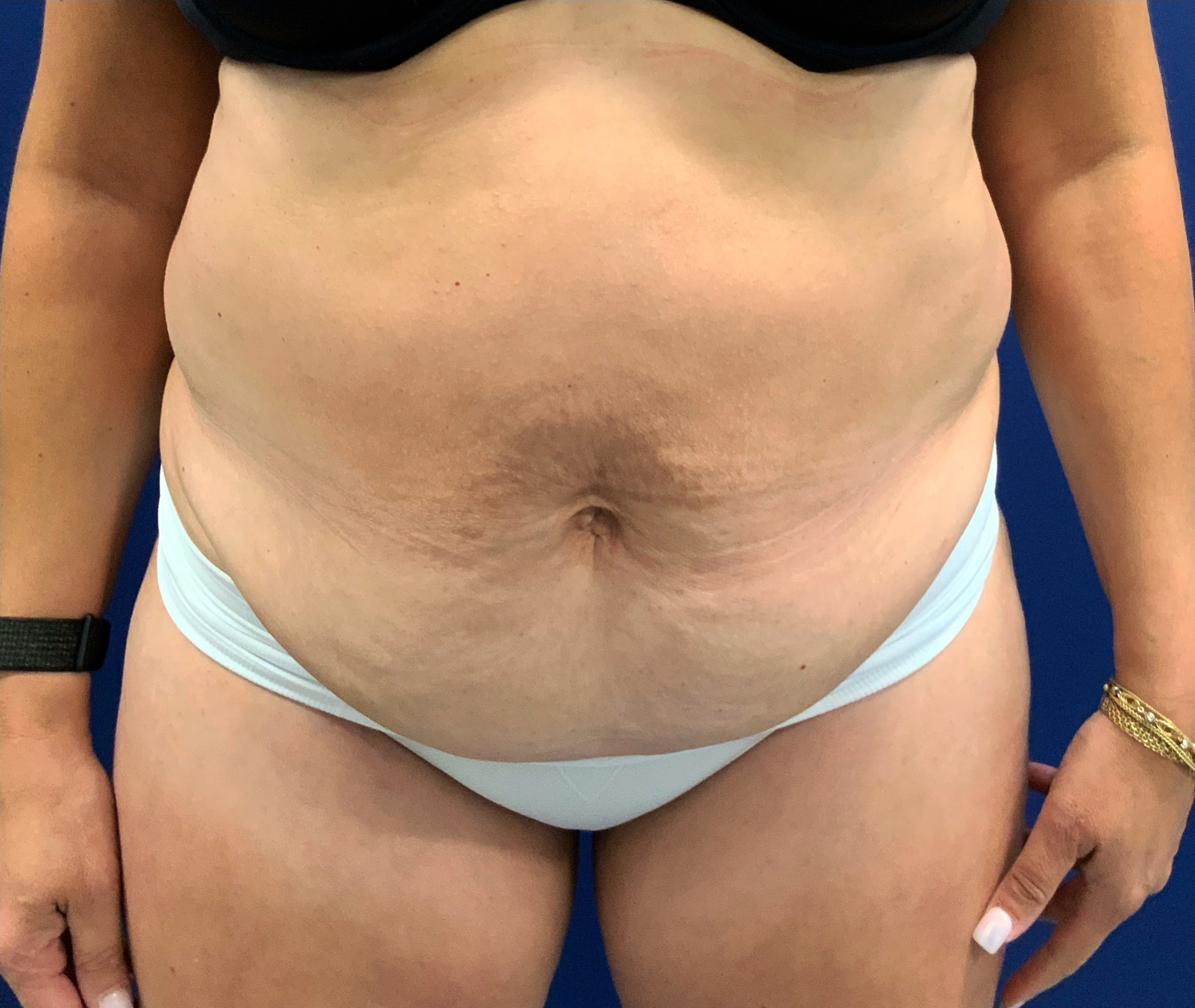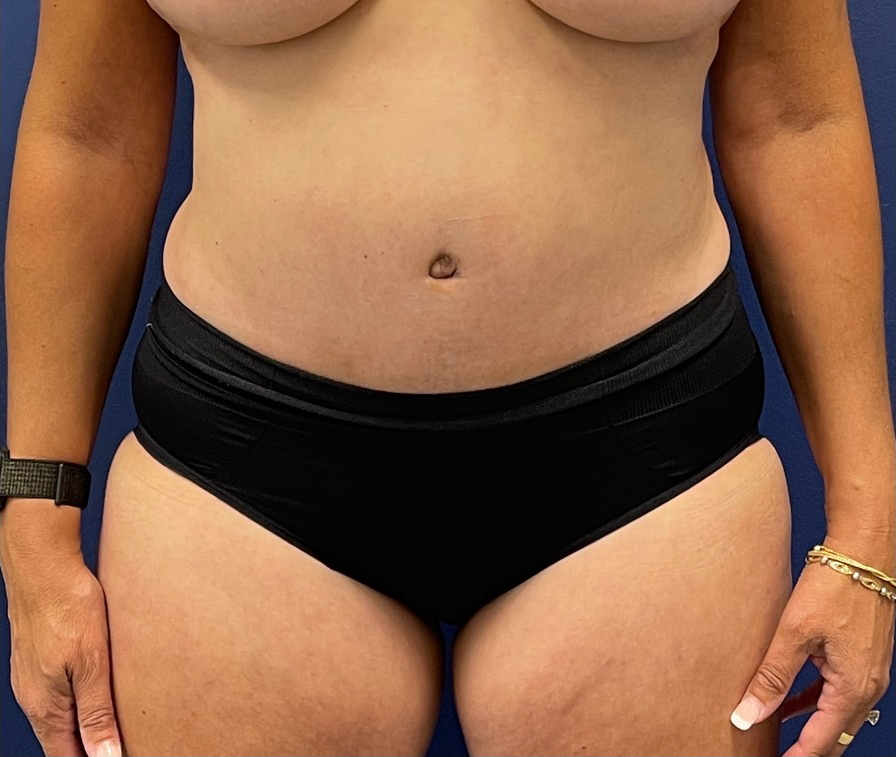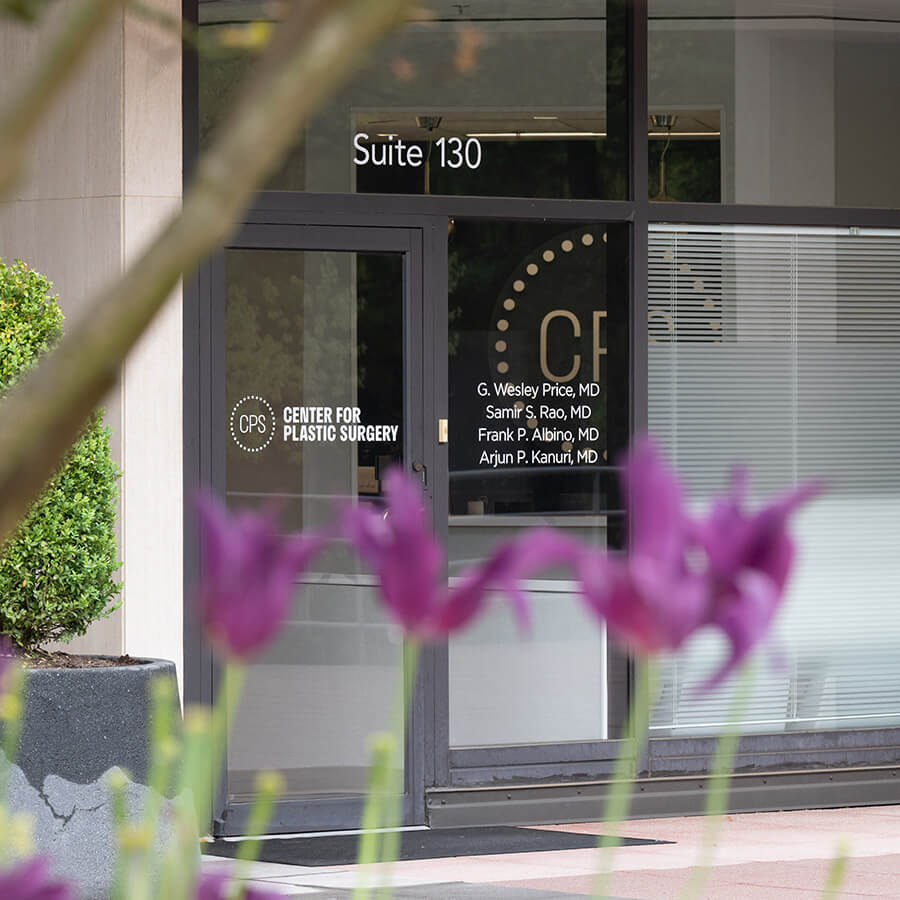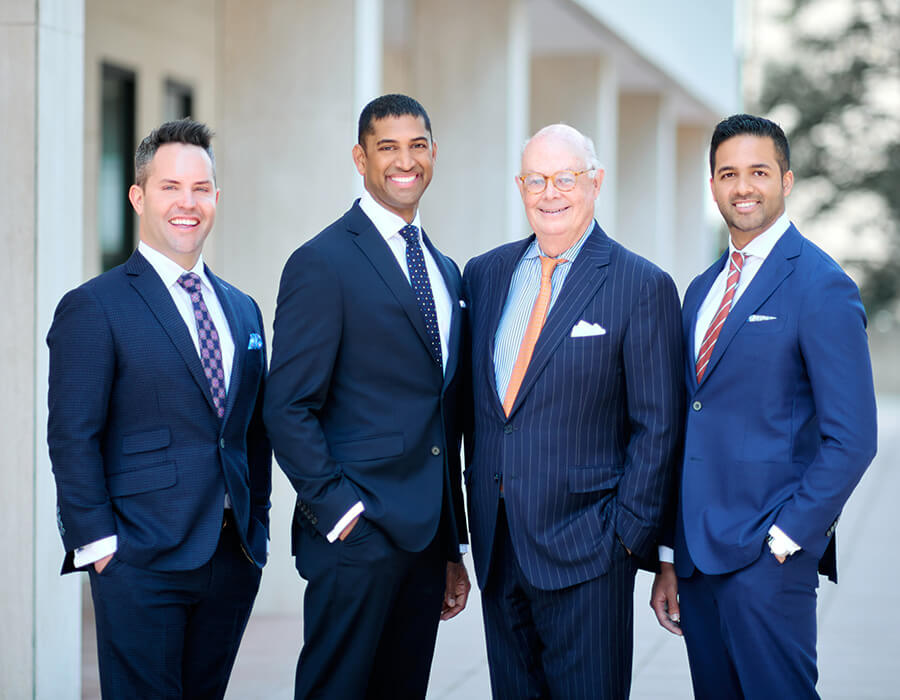If you want to slim your midsection and erase unsightly excess skin with a tummy tuck, you have several options for customizing your procedure at CPS. Our surgeons are experienced in various types of tummy tuck techniques and incisions, which they personalize to each patient’s individual needs. The goals of all tummy tuck procedures are a low, easily concealable scar, a natural-appearing belly button, athletic and elegant contours, and repair of separated abdominal muscles.
Tummy Tuck in Washington D.C.
A slim, toned abdomen is widely considered a body ideal for both men and women, but when pregnancies, major weight loss, and the natural aging process take their toll, that ideal is close to impossible to achieve. Stretched abdominal muscles, excess, hanging skin, and pockets of stubborn fat can make it difficult to get the body you want. A tummy tuck or abdominoplasty is a body contouring procedure designed to eliminate loose skin and fat, as well as surgically repair lax abdominal muscles for a result unlike any other.
Our team of board-certified plastic surgeons has been successfully performing tummy tuck procedures for decades, consistently providing our Washington, D.C., metro area patients with wonderful results. It’s no surprise that so many of them feel newly empowered and have had their confidence restored.


Before & After Photos


What Are the Benefits of a Tummy Tuck?
A tummy tuck remains one of the most successful methods of trimming excess fat and skin from the midsection, providing a slimming and contouring result that can last for years. Tummy tucks are immensely popular with post-partum women and patients who have lost a significant amount of weight, as this procedure allows our surgeons to surgically tighten loosened abdominal muscles, repairing the integrity of the abdominal wall. Other tummy tuck benefits include:
- Permanent removal of loose or hanging abdominal skin
- Slimmer contours
- Repaired abdominal wall
- Repositioned belly button
- Removed pockets of fat
Tummy tucks are nothing short of transformational; view our tummy tuck photo gallery to see real results from our surgeons.
Am I a Candidate for a Tummy Tuck?
Both weight loss and pregnancy are exciting life events, but they come with some challenges when your body doesn’t snap back the way you want it to. If your midsection has loose skin and stubborn pockets of fat, and you have difficulty seeing results through exercise, a tummy tuck may be for you. Candidates for a tummy tuck:
- Want to repair damaged abdominal muscles
- Desire a slimmer, more contoured appearance
- Are generally in good health
- Do not smoke or are willing to quit
- Have realistic expectations for results
What Are My Tummy Tuck Options?

We use liposuction to help achieve these goals in all tummy tuck procedures. Based on your anatomy and goals, there are a few different types of tummy tuck procedures we may recommend. Options include:
Mini Tummy Tuck
This least invasive abdominoplasty technique involves a small incision about the size of a C-section scar. It rejuvenates the lower abdomen—below the belly button—by removing lax skin, repairing abdominal muscles below the navel, and tightening the skin that hangs over a C-section scar. This option would be best for patients who only have excess skin below the belly button and who want a shorter recovery process.
Standard (Complete) Tummy Tuck
This technique involves a low incision placed just above the pubic bone that spans horizontally between the hip bones. A second incision encircles the inside of the bellybutton. A standard tummy tuck, the most commonly performed technique, improves the appearance of the abdomen from below the ribcage to the pubic bone by removing lax skin (as well as stretch marks on that skin) and repairing separated abdominal muscles (diastasis recti). This tummy tuck with muscle repair procedure often includes a panniculectomy to remove skin that hangs over the pubic area.
Extended Tummy Tuck
This technique extends the standard tummy tuck incision up and around the flanks to remove more skin and fat laterally. This is ideal for people with significant skin laxity and who want a flatter abdomen and some hip contouring.
A Reputation Built on Results

ESTABLISHED EXCELLENCE
Choose the experts that locals know and trust. Our multigenerational practice includes board-certified plastic surgeons who provide the best possible care with state-of-the-art technology.
How Tummy Tucks Compare to Similar Procedures
Body contouring procedures often feature some overlap in techniques, treatment areas, and results. However, each procedure has a specific purpose which must reflect the goals and needs of the patient. Below are some more variations for tummy tucks, as well as complementary procedures that may provide similar results or are popularly combined with abdominoplasty.
Tummy Tucks vs. Liposuction
While tummy tuck surgery and liposuction are both body contouring procedures, they cannot be used interchangeably.
- Liposuction removes areas of unwanted fat; it does not tighten the skin.
- Tummy tuck surgery tightens lax abdominal skin, and repairs stretched abdominal muscles.
While some patients benefit from a tummy tuck without liposuction, our surgeons often combine tummy tucks with liposuction of the flanks and waist for more comprehensive contouring. This blog post can help you determine which procedure (or combination of procedures) is right for you.
Tummy Tuck vs. Body Lift
A body lift is a personalized combination of procedures that usually includes a tummy tuck, thigh lift, and buttock lift. Body lifts benefit people who have undergone significant weight loss and have a lot of excess, sagging skin around their abdomen and lower body.
Tummy Tucks vs. Mommy Makeovers
Mommy Makeovers are actually multiple body contouring procedures performed in one surgical setting, each aimed at restoring a woman’s body after pregnancy, childbirth, and breastfeeding. With this customizable procedure, many women choose to include a tummy tuck for its ability to repair the midsection, but other common procedures include breast lifts, breast augmentations, and liposuction.
Tummy Tucks for Men
While most tummy tuck patients are women, men who want a firmer, more contoured midsection can also benefit from the surgery. Because men tend to store belly fat behind the abdominal muscles where it cannot be removed with liposuction or surgery, the best candidates are men who are happy with their weight. The incision is usually higher and less curved for male versus female patients. Men often benefit from liposuction of the flanks with their tummy tuck.

How Is a Tummy Tuck Performed?
Your Tummy Tuck Consultation
Your tummy tuck consultation is a critical part of your plastic surgery process. During your meeting with one of our board-certified plastic surgeons, you will have the opportunity to ask any questions you may have, discuss the risks and benefits of a tummy tuck, and get a good idea of what you can reasonably expect from the results.
As this page suggests, there are several options for tummy tucks offered at CPS, so your plastic surgeon will listen to your goals for the procedure, examine your abdomen, and create a plan that incorporates the best tummy tuck technique for you.
The Tummy Tuck Procedure
Our surgeons perform tummy tuck surgery at local hospitals and in our private, accredited surgery center based in our Virginia office. Although most tummy tucks are outpatient surgeries, some patients choose to spend the night for convenience or because they are coming from out of town. We can help arrange hotel rooms as well as around-the-clock and overnight nursing care for those patients who are interested in this option.
On the day of surgery, your surgeon will check in with you to say hello and go over your surgical plan with you once more. They may also mark the incision locations on the treatment area in pen. You will be administered general anesthesia, and the surgery will begin.
During a standard tummy tuck, our surgeons make a horizontal incision low on the abdomen, just above the pubis, in a natural skin fold, separating the excessive skin from the underlying muscle layer of the abdominal wall. This allows us to examine the muscles and their covering layer and to repair any weaknesses or laxity.
Achieving a flat abdomen usually requires repairing this muscle layer. In most cases, we also perform liposuction of the abdomen and waist to help further sculpt the area. We can also use the J-Plasma treatment to further smooth and tighten the skin if desired. We place you in a special garment to provide gentle, even pressure while you are still asleep. This helps prevent fluid accumulation in the surgical area and protects the deeper muscle repair.
What Can I Expect From Tummy Tuck Recovery?
Following surgery, you will be sent home with specific aftercare instructions from your surgeon. We also require that you have a responsible friend or family member take you home from surgery and stay with you to help care for you, any young children, and your pets for the first few days. Most patients take two weeks off of work after a tummy tuck.
You will return home from surgery in a post-surgical compression garment that puts gentle pressure on the midsection. The garment is necessary to support healing tissues and help minimize swelling around the surgical area. Our surgeons will help measure and guide you in choosing your garments. They will also instruct you on when to wear it and for how long. They will also let you know if you need a Stage 2 garment in the later stages of your recovery.
If postoperative lymphatic massage is deemed a helpful recovery option that you are interested in, we also work with multiple providers and can help guide you on where to go and when.
Expect to feel stiff, with limited mobility for a few days. Sleeping may be difficult initially: You will need to keep yourself hunched over to prevent strain on the incision and abdominal muscles; therefore, you will need to sleep in a recliner or propped up with pillows in bed. Sleeping on your stomach or side can strain your incisions and result in postoperative complications.
While you should avoid strenuous exercise or athletics initially, we will encourage you to take gentle walks throughout the day to decrease the risk of blood clots and to induce healing. If needed, we may also prescribe you a blood thinner after surgery to help further reduce the risk of blood clots.
Tummy Tuck Recovery Timeline
Be sure to follow your surgeon’s recovery instructions to the best of your abilities; Tummy tuck recovery can be challenging, so be sure to call our office if you have any questions or concerns at any point. Below is a general timeline of tummy tuck recovery, but be advised that each patient will be a little different than the next.
- Drains removed
- Discomfort peaks
- Take a shower (after 48s hrs)
- Stand upright
- Return to work and nonstrenuous exercise
- May start postoperative lymphatic massages
- Resume low-impact exercise
- Switch to Stage 2 compression garments
- Sleep on your side (when cleared)
- Resume strenuous exercise (when cleared)
- Swelling fades (about 80% gone)
- See improved contours
- Ready to sleep on your stomach (when cleared)
-
Final results
How Much Does a Tummy Tuck Cost?
The cost of a tummy tuck in Washington, D.C., starts at $13,000 and goes up from there, depending on the amount of correction needed and the technique used.
After your consultation with one of our surgeons, we will be happy to provide you with an accurate cost estimate. Patient financing is available for qualified patients. For the highest level of safety and the best tummy tuck results, choose a surgeon based on credentials, not price.

Tummy Tuck Frequently Asked Questions
Do all tummy tucks require drains?
Even though our plastic surgeons use drains in most of our tummy tuck procedures, there is an occasional patient for which they do not use drains. Drains serve an important purpose, which is to prevent fluid from building up (seromas) in the space that was created by the separation of tissues during the procedure.
In addition, our surgeons typically use the same technique that surgeons who offer drainless tummy tucks use, which is placing internal quilting stitches to tack down the overlying abdominal flap to the abdominal wall. They find this helps decrease the amount of drainage. Because some drainage does develop anyway, using drains to remove it helps speed up the recovery process.
Will I have scars after my tummy tuck?
Scars are a necessary consequence of any surgery. Our surgeons do their best to place tummy tuck incisions where the scar is easily concealed by undergarments and swimsuits. Most patients say that scars are a worthwhile tradeoff for the improvements they attain.
Tummy Tuck Scar Healing Stages
Tummy tuck scars change over the first year, progressing through the following stages (patient experiences vary):
- 1 month: Incision is sealed, and scar begins to form.
- 1 to 6 months: Incision is healed completely. The scar is pink or red, raised, and might feel bumpy.
- 6 months: Scar gradually loses its pigmentation and may appear light pink or soft brown.
- 8 to 12 months: Scar is mature; it has thinned, flattened, and lightened to a silvery white.
You can help minimize scarring by wearing your compression garment consistently and applying silicone gel or sheets as directed by your surgeon. When used for the first 6 weeks after surgery, silicone products can help form scars that are as thin and flat as possible. Avoid sun exposure on your scar, as this can cause it to heal inadequately.
How painful is tummy tuck recovery?
Pain after a tummy tuck is mainly due to abdominal muscle repair. Our surgeons use the drug Exparel® in these cases to provide significant pain relief for the first few days after surgery when it is typically most intense. This opioid-free drug is administered intraoperatively by injecting it into the muscles of the abdominal wall.
Throughout your recovery process, pain can be managed by over-the-counter medications or pain medication prescribed by your plastic surgeon. We use the latest in enhanced recovery and pain management protocols to minimize the use of narcotic pain medications. After about the first week, though, tummy tuck recovery becomes much more manageable and your pain should be reduced.
How can I maintain the results of my tummy tuck?
If patients maintain their weight, exercise consistently, and do not become pregnant, tummy tuck results can last indefinitely. The aging process will continue but typically does not impact the abdominal area significantly.
You can also maintain the results of your tummy tuck by maintaining a healthy weight through diet and exercise. Many tummy tuck patients find that after their initial recovery period, their repaired abdominal wall and slimmer physique make exercise more effective and enjoyable. With proper diet and exercise, you can enjoy the results of your tummy tuck for years to come.
Interested in a Tummy Tuck in Washington, D.C.?
If you want to slim your midsection with lasting, visible results, fill out our contact form or call Center for Plastic Surgery today at (301) 652-7700. Our team of board-certified plastic surgeons, experienced medical providers, and compassionate support staff are ready to help you experience the CPS difference.